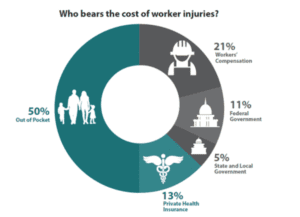
Do you feel that injured workers who receive workers comp are really “milking the system?” Most people are under the impression that the costs of on-the-job injuries are taken care of via the workers' comp system. However, according to OSHA, that isn't the case. In a 2015 report that sheds new light on the importance of preventing workplace injuries, OSHA shows that only a small percentage of overall costs of workplace injuries are covered by employers through workers' compensation, with the rest borne primarily by injured workers, their families, and taxpayers.
Despite the good intentions behind workers' compensation programs, they have never completely covered the costs of on-the-job injuries – a fact that many employers are surprised to hear, given the costs to businesses associated with these programs. Additionally, according to OSHA, over recent years, the gap between the actual costs of employee injuries and what workers' compensation covers has likely increased, as many states have made changes in their workers' compensation systems that make obtaining benefits more difficult for injured workers. They state that currently, only a small proportion – about 21 percent – of the overall costs of on-the-job injuries are actually paid by workers' comp.
So who pays the rest? OSHA's report shows that about 50 percent of the overall cost is paid out-of-pocket by the injured workers and their families. About 13 percent is paid by private health insurance. Workers' compensation makes up 21 percent, with the federal government footing the bill for about 11 percent of the total cost of work-related injuries and state and local governments paying out about five percent.

What this means is that preventing workplace injuries isn't just important for controlling the workers' comp costs your business pays out. Those injuries also impact taxpayers, including yourself and your company, who fund federal, state, and local disability and medical assistance programs. The largest toll of unsafe employers and workplaces by far is the financial hardship faced by injured employees and their families – a toll that, in cases of serious, debilitating injuries, may impact them for the remainder of an injured employee's lifetime and even beyond.
What Can Your Company Do to Reduce Its Contribution to This Problem?
Minimizing injuries in your workplace reduces their impact on everyone involved, including your company, other taxpayers, and your employees and their families. The most effective approach is a comprehensive hire-to-retire philosophy, and includes:
By implementing this complete Hire-to-Retire MSD prevention approach, you’ll achieve the best possible results in terms of injury prevention and post-injury management, saving work comp expense and increasing productivity and profitability.
But if you’re not ready to bite off the entire suite of services, there are several options. Many organizations roll out one service at a time to eventually achieve a complete suite of services. Others choose a pilot location where most of the injuries are occurring for launching the programs.
The best place to start depends on the types of injuries, the jobs that are creating them, and when in the worker lifecycle they are occurring. So, it pays to start with a thorough analysis of your injuries in order to achieve an optimal ROI.
ErgoScience can help you focus your efforts to make the most of your investment.

ErgoScience makes the workplace better by applying evidence-based injury prevention through proven, defensible methodologies.


Proudly built by Adam Black Media Copyright © All rights reserved.
Our goal is to help people in the best way possible. this is a basic principle in every case and cause for success. contact us today for a free consultation.